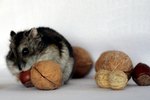
Hamsters receive the nutrition they need from their regular feed, but they enjoy tasty, fresh treats in moderation. This includes fresh fruit and veggies as well as nuts such as almonds. Sweet almonds are safe for your cuddly friend, but take extra care to make sure you give him the sweet variety rather than bitter almonds. Bitter almonds contain a cyanide compound, and eating even one bitter almond can kill your hamster. The US Department of Agriculture allows almonds packaged as sweet to contain up to 1 percent bitter almonds, which means a couple of bitter almonds might be mixed in with your sweet almonds.
Step 1
Buy organic almonds without shells. Non-organic varieties might contain small amounts of chemicals, such as those used in pesticides. Ingesting even tiny amounts of these chemicals can harm or kill your hamster.
Step 2
Examine the almonds carefully. Remove any that don't have the perfect almond shape. An almond with an irregular shape or one that's shorter and wider than a typical almond might be a bitter almond. Feed your hamster only the largest, best-shaped almonds.
Step 3
Soak the almonds in hot water for 15 minutes to soften the skins. Pinch the large end of each almond when it cools to slide the skin off. The skin can irritate your hamster's tummy, so it's best to remove it.
Step 4
Give your hamster no more than half an almond each day if she is a small variety, or no more than a whole almond per day if she's a medium or large hamster. Almonds and other nuts are high in fat, which can lead to dangerous weight gain if given in large quantities. Almonds should be considered a special treat rather than a diet staple.
References
Tips
- Instead of taking the chance of feeding your pet a bitter almond, try giving him other safer types of nuts, such as peanuts, walnuts and cashews. You can even give him these nuts in their shells, letting him play with the shell until he successfully opens it.
Warnings
- Make sure any nuts you give your hamster are unsalted. Too much salt can wreak havoc on his little system, possibly leading to salinity poisoning.
Photo Credits
-
almond image by L. Shat from Fotolia.com


